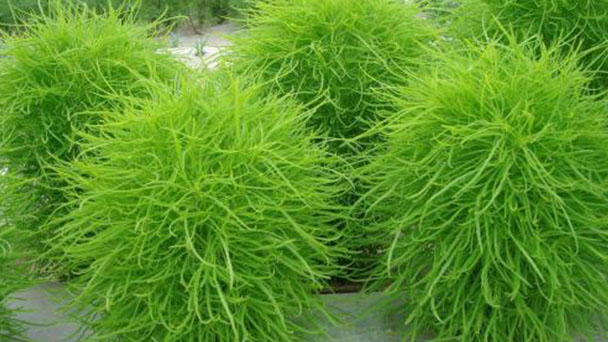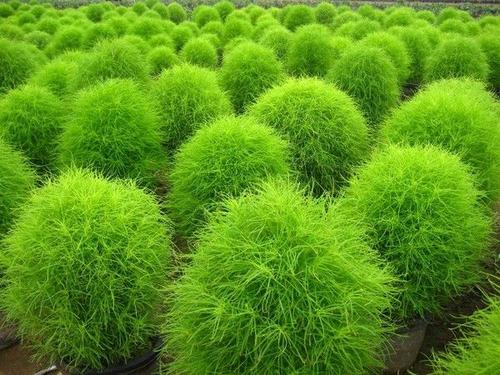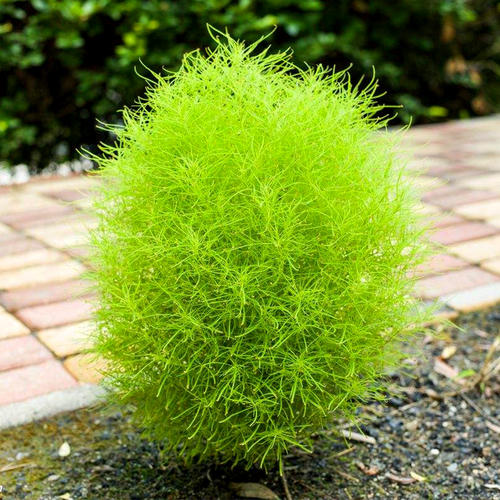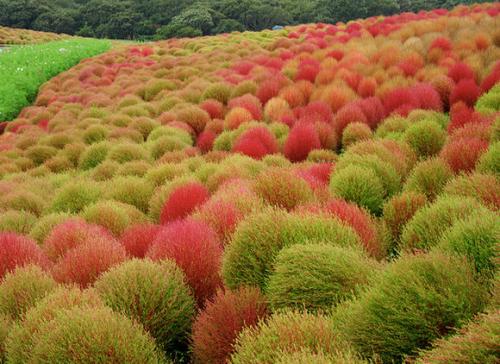Kochia scoparia profile
Written by Maggie
Feb 26 2021

Kochia scoparia, aliases: ground wheat, broomstick, broomstick seedling, broom cabbage, peacock pine.
Kochia scoparia plant clusters are compact, obovate to globose, obovate or elliptic, with many thin branches, pubescent, and semi-lignified stem base. Stem branching many, leaves of Kochia scoparia are linear-lanceolate, alternate leaves, leaves linear, linear or striped. Spicate, open red - brown florets, small flowers, no ornamental value, cytoplasm oblate spherical. The Kochia scoparia is light green with reddish leaves in autumn. Fruit oblate spherical, can be used in medicine, called Kochia scoparia seed. The young stems and leaves can be eaten, and the old plants can be used as brooms.
Kochia scoparia picture

Morphological characteristics of Kochia scoparia
Rhizome
Kochia scoparia is an annual, 50-100 cm tall. The roots are slightly fusiform. Stems are erect, terete, pale green or purplish red, with many edges, slightly pubescent or lower parts barely glabrous; Branches are sparse, oblique.
Leaf
Leaves of Kochia scoparia are flat, lanceolate or strip-lanceolate, 2-5 cm long and 3-9 mm wide, glabrous or slightly hairy, apex short acuminate, base tapering into a short stipe, usually with 3 distinct main veins, margin sparsely fringed with rusty silky cilium; Stem upper leaves smaller, sessile, 1-veined.
Flowers
Flowers of Kochia scoparia are bisexual or female, usually 1-3 in upper leaf axils, forming sparsely spiked panicles, sometimes with rust-colored pubescent hairs below; Perianth is subglobose, pale green, perianth lobes subtriangular, glabrous or slightly hairy at apex; Wingtip appendages of Kochia scoparia are triangular to obovate, sometimes subflanate, membranous, veins inconspicuous, margin microwave-like or notched; Filaments are filiform, anthers pale yellow; Kochia scoparia has 2 stigmas, filiform, purplish brown, style very short.
Fruit
The cytoplasm of Kochia scoparia is oblate, the pericarp is membranous, separate from the seed. Seeds are ovate, dark brown, 1.5-2 mm long, slightly glossy; Embryo annular, endosperm massive.
Ecological habits of Kochia scoparia
Kochia scoparia is highly adaptable, tolerant to temperature, light, drought, not cold, not strict with soil requirements, and tolerant to alkaline soil. Fertilizing, loose and humus rich loam soil is conducive to the vigorous growth of Kochia scoparia.
Kochia scoparia growing methods
Kochia scoparia has strong adaptability and can be planted in the north and south of the country without strict requirements on soil. Kochia scoparia can be planted in front of the house, behind the house, in the edge of the ground and in the corner of the ground. Propagate with seeds and sowin spring. Pour permeable water before sowing, drill, row spacing 0.5-0.8 meters, soil 0.4-0.5 cm, sowing amount of 1kg/667m2, slightly repressed after sowing. Keep the soil moist and let the seedlings emerge in about 10 days. Seedling out of Qi to timely thinning, seedlings, and timely soil, weeding, timely watering, applying top dressing 2-3 times a year.When autumn fruit is mature, cut the whole grass, dry the fruit, remove impurities, dry in the sun for standby. Cut the stem and leaves into sections and dry in the sun.
Semination
The optimum germination temperature for Kochia scoparia is 10-20℃. Seedlings can be raised by direct seeding on bare ground or transplanting on protected ground. Live streamed naked will be available in spring. Hole sowing, drill sowing, broadcast sowing. Seedling in protected areas can be carried out in spring. Although Kochia scoparia is more resistant to drought and is not strict with soil, it is necessary to water and apply a certain amount of organic fertilizer before sowing. The thickness of the soil should be 1-1.5 cm.
Field management
Kochia scoparia seedling or transplanting. If direct seeding on bare ground is adopted, when seedlings grow to 15-20 cm high, seedlings can be set according to the row spacing of 70-100 cm in combination with harvested seedlings. If the seedlings are raised in protected areas, they can be transplanted when the seedlings grow to 6-10 cm.
Sewage sludge management
In addition to the application of foot fertilizer, in the thinning and slow seedling, combined with irrigation and rinse application of a quick soluble biological organic fertilizer 150kg/hm2. Although Kochia scoparia is more tolerant to drought, keeping the field wet not only improves the yield, but also improves the quality of its products. Therefore, the growing period should be every 7-10 days to water.
Timely recovery
Generally, the seedlings of Kochia scoparia can be harvested when the plant grows to 15-20 cm high, the stems and leaves of the tender can be harvested, and the whole Kochia scoparia or seed can be harvested after the beginning of autumn.

Propagation of Kochia scoparia
Sowing propagation, spring sowing, suitable for direct broadcasting. The seeds of Kochia scoparia are planted in the open bed in spring and germinate quickly and neatly. After thinning, the planting spacing was 50cm.
Weed management in Kochia scoparia
The main methods of weed control in farmland include manual control, chemical control, mechanical control, alternative control and ecological control. Using mulch, shading and other principles, with plastic film mulch or sowing other crops (or grass seed) methods for weeding.
Manual control
Control weeds seeds into the field of artificial control was first as far as possible do not make the weed seeds or reproductive organs into the crop fields, remove juggle, roadside weeds, strict system of weed quarantine, selection of planting material, pay special attention to a domestic or not yet Widespread weeds must be strictly forbidden to enter or kept under strict control, to prevent spread, to reduce the source field weed.When compost is retted with weeds, the compost containing weed seeds should be covered with thin film and compost at high temperature for 2-4 weeks to decompress into organic fertilizer and then use it after killing its germinating power.
Artificial weeding is combined with agricultural activities, such as pulling or eradicating weeds directly after germination or during growth period, or weeding with agricultural measures such as intertillage fertilization.
Disease control of Kochia scoparia
Kochia scoparia is susceptible to aphids and can be controlled with a 40% dimethyl oil solution of 1000-1200 times. Kochia scoparia is also susceptible to dodder and should be removed immediately.
Species taxonomy of Kochia scoparia
Alkali Kochia scoparia
The difference between this variety and the original variety is that there are dense bundles of rust-colored pubescent under the flowers.
Kochia scoparia
F. Trichophylla (Hort.) Schinz et Thell. One branch is numerous, the plant is ovate or obovate;Leaf is relatively narrow.Cultivated for use as a broom. The leaves and branches turn red in late autumn and are available for viewing.
The distribution of Kochia scoparia
Kochia scoparia is distributed in Asia, Europe and most parts of mainland China. Kochia scoparia grows from 50 m to 3,200 m above sea level. Kochia scoparia is commonly found along roads, fields and wasteland.
Chemical constituents of Kochia scoparia
Kochia scoparia shoots are rich in potassium and beta-carotene. Per 100g of edible portion, the content of protein: 5.2g, fat: 0.8g, carbohydrate: 10.2g, beta-carotene: 5.7mg, vitamin A: 953mg, vitamin C: 39mg, K: 702mg, Ca: 281mg, Fe: 6.5mg.
Kochia scoparia main value
Edible value
Kochia scoparia is a semi-wild vegetable high in beta carotene and potassium and copper. Kochia scoparia is usually fried in boiling water, served in a salad or as a filling. Kochia Scoparia stir-fried shredded pork is bright in color and tastes fresh and refreshing. It can be used to make cakes.
Landscape use of Kochia Scoparia
Landscape utility
Kochia scoparia can be used in flower beds, flower borders, flower bushes, flower groups.
Kochia scoparia is used for placing hedges, flower borders, or clusters in the center of flower beds, which can be trimmed into a variety of geometric patterns for arrangement. Potted Kochia scoparia can be decorated and decorated in halls, halls, venues, etc. Garden cultivation is mainly its variety of fine leaf broomstick (var.culta) : the plant shape is small, the leaves are soft, tender green, and turn to red purple in autumn.
Art form
Kochia scoparia is a spherical plant with beautiful branches and leaves. Kochia scoparia looks like a small cypress. Kochia scoparia has delicate leaves and graceful plant shape, bright green and turns red in autumn. Through the trimming modeling such as geometric patterns, groups of words and so on combined with the flower bed for the main scene or lining scene. Kochia scoparia can also be planted on both sides of the road, corridor on both sides.
Foil landscape
Kochia scoparia, as a colorful leaf cover plant, can be planted in groups in flower borders, flower beds, or with brightly colored flowers, which can be used to decorate scattered open Spaces. In the mound, rockery with the slope, high and low scattered, density alternately, can form a unique landscape. At the same time, Kochia scoparia is also one of the important summer flower bed plants, its light green, brings people a feeling of cool in the hot summer.
The old spring leaves of Kochia scoparia can be used as fodder, and the seeds contain 15% oil for both edible and industrial use.

Latest Updated
- Benefits of Bugleweed - 7 Science-backed Health Benefits
- Bugleweed Dangers & Side Effects - Is It Poisonous?
- How to Plant Evergreen Trees - What You Should Know
- When to Plant Evergreens - Grow Guide for Evergreen Trees
- 12 Wonderful Evergreen Shrubs for Your Garden
- 12 Popular Evergreen Plants with Pictures for Beginners
- When And How To Prune A Lilac Bush Like a Pro
- How to Grow & Care for Lilac Vine (Hardenbergia Violacea)
- Japanese Lilac Tree (Syringa Reticulata) Care & Propagation Guide
- Shumard Oak Pros and Cons - What to Know
Popular Articles
- Winter maintenance of Antirrhinum Majus
- How to Grow Terminalia Mantaly Tree
- How to Grow and Care for Crossostephium Chinense
- How to grow Antirrhinum Majus in spring
- Peristeria Elata (Dove Orchid) Profile: Info & Care Guide
- Underwatered Snake Plant (Sansevieria Trifasciata) - Signs And How To Fix
- How to Care for Brazilian Jasmine Plant (Mandevilla Sanderi)
- How to Grow & Care for Graptopetalum Purple Delight in Summer
- Rosa Chinensis (China Rose): Plant Growing & Care Tips
- How to Care for Baby Sun Rose (Aptenia Cordifolia)